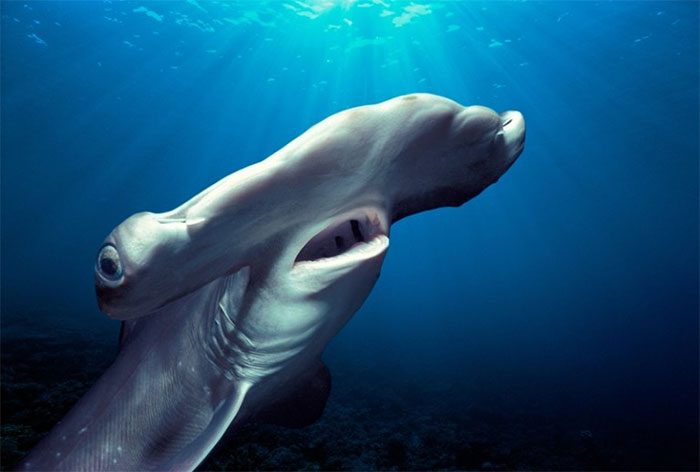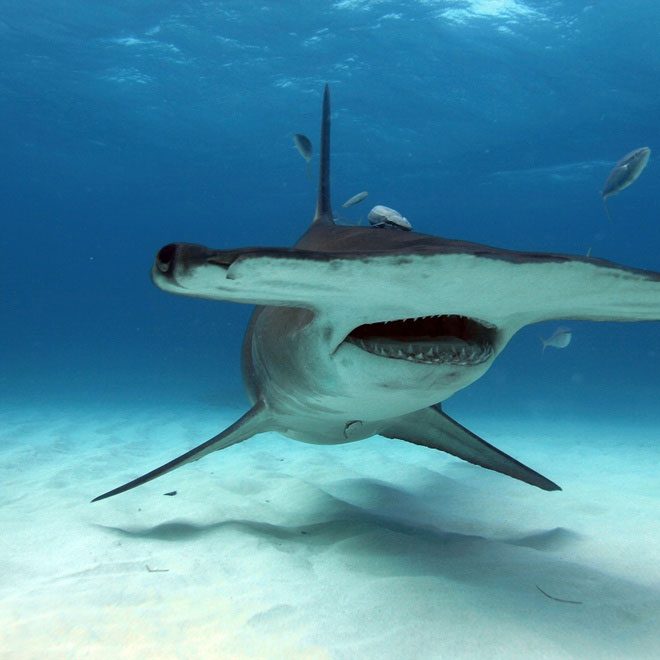The hammerhead shark has developed a unique mechanism to avoid losing body heat while hunting in deep, cold waters: it closes its gills and holds its breath.
Many species of fish and marine mammals dive from the warm surface of the sea to hunt in deeper waters. During this hunting process, ectothermic or cold-blooded species face the challenge of maintaining their body temperature in water temperatures that are just a few degrees Celsius, close to freezing.

A hammerhead shark with its mouth and gills open, near the ocean surface off Hawaii. (Photo: Biosphoto/Alamy)
“The point of fastest heat ‘loss’ for any fish species is in the gills,” Mark Royer, a physiologist studying shark behavior at the Hawaii Institute of Marine Biology, told Nature. There is a large volume of warm blood flowing through the gills, making this part essentially a giant radiator attached to the head.
Royer stated that hammerhead sharks maintain their body temperature by simply ‘holding their breath’, not opening their gills or mouth while diving. Without water flowing over their gills, these fish do not lose body heat to the environment.
Some species, such as the whale shark, retain heat while diving due to their massive size. Others, like tuna, swordfish, great white sharks, and mako sharks, have developed specialized heat exchange systems in their gills to prevent excessive body heat loss. The hammerhead shark lacks these advantages or adaptations but is capable of diving quickly and repeatedly to depths of around 800 meters.
To uncover the secrets of the hammerhead shark, Royer’s team used instruments to measure depth, water temperature, location, and fish movement, along with a probe attached near the dorsal fin to record the body temperature of the shark. Three hammerhead sharks off the coast of Hawaii were equipped with this gear.
Results published in Science revealed that hammerhead sharks dive about six times, each lasting about 5-7 minutes, during each hunting excursion, descending to depths with temperatures between 5-11 degrees Celsius, which are about 20 degrees colder than the surface. Despite this, their body temperature remains almost constant throughout the dive.

Hammerhead sharks lack size advantages but possess remarkable diving capabilities. (Photo: National Geographic).
The body temperature of hammerhead sharks only decreases when they approach the surface, coinciding with when they start breathing again, allowing water to flow over their gills.
This breath-holding mechanism indicates that hammerhead sharks can cope with a drastic reduction in blood oxygen levels during dives, according to Mark Meekan, an ecologist at the Ocean Institute of the University of Western Australia in Perth.
“They have the ability to slow their heart rate, which reduces the pumping of blood throughout the body. The tissues and blood of hammerhead sharks may have evolved to hold more oxygen per unit volume, similar to adaptations seen in high-altitude dwellers,” Meekan said.
So far, hammerhead sharks are the only fish species known to exhibit such breath-holding capability. However, experts hypothesize that there may be other shark and fish species that could possess similar adaptive mechanisms, as this is a significant advantage when hunting in cold water environments.


















































